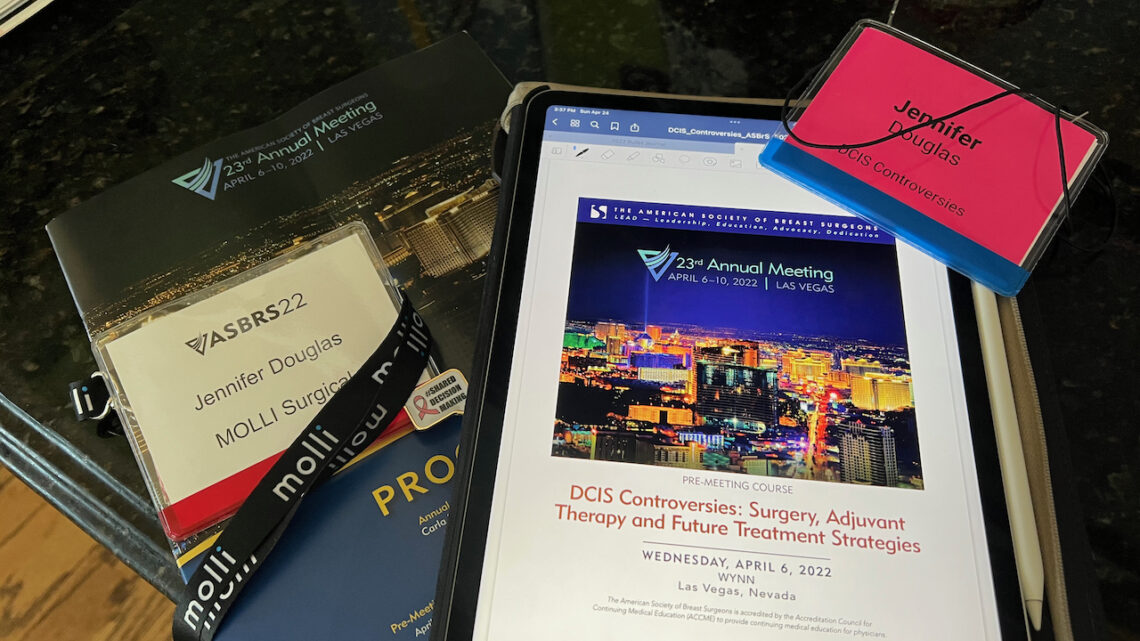
DCIS Matters: 15 Takeaways from the 2022 ASBrS DCIS Controversies Course
After a day of learning about DCIS treatment, research, and future treatment options, I had pages of notes and plenty of hope. DCIS matters, and that is encouraging! It was amazing to sit with surgeons from all over the world and learn with them. My notebook is full of details that I am excited to share. For this post, I wanted to share some of my takeaways from this 2022 DCIS Controversies course at the American Society for Breast Surgeons Conference (ASBrS).
Note: I am not a medical professional, and all of this information should be taken as general information on the topic, not as medical advice. See my Disclaimer for more information.
15 Takeaways from the DCIS Course at ASBrS 2022
- DCIS Matters: It was obvious right from the beginning that everyone in the room was passionate about DCIS. I’ve never been around so many people at once who cared about DCIS. It was quite encouraging.
- There are about 50,000 cases of DCIS in the US diagnosed each year. Since DCIS is regularly picked up on screening mammograms, the number of DCIS cases diagnosed annually can be paralleled to the number of mammogram machines in the United States.
- In the 1980s, it was commonly believed that DCIS was a precursor to invasive breast cancer. This was considered the linear model of cancer progression. Tissue was thought to progress from normal to DCIS to invasive. But, that doesn’t seem to be the case.
- Not all DCIS will progress: Researchers know that some DCIS will not become invasive. About 25% of DCIS will likely progress. This leaves 75% of DCIS as non-progressive.
- Which DCIS will progress is still a mystery: Research continues in the biology of DCIS to figure out which DCIS has the potential to invade and which will sit in the duct and not present a problem.
- Can DCIS be safely watched? Several studies are going on to see if active surveillance may be added to the list of treatment options for patients. The COMET study is one of those being conducted in the US.
- Active Surveillance is not a part of the current standard of care for DCIS patients outside of clinical trials.
- Previous estimates of breast cancer overdiagnosis were inflated: The latest research indicates that about 15% of screen-detected breast cancers would be considered overdiagnosed. This is a drastic reduction from previous estimates of nearly 30%.
- Surgical margins are an important factor in recurrence. If a patient is going to proceed with radiation, then closer margins may be acceptable and might not warrant a second surgery.
- New tests help in the decision-making about radiation: DCISionRT is a test that looks at the biology of the DCIS and gives a report as to whether the patient would have a low benefit from radiation or a high benefit from radiation.
- New radiation treatment options include accelerated partial breast radiation and interoperative radiation. These are both effective choices and can reduce the duration of treatment for patients.
- Endocrine therapy and DCIS: trials are happening to evaluate low-dose tamoxifen and tamoxifen gel.
- Vaccine Development– research is going on to see if vaccines can be developed to help our immune system recognize breast cancer cells and kill them.
- Survivorship care should begin on the day of diagnosis, and surgeons should be equipped to offer resources to patients.
- Since the survival rate of DCIS is so high, preserving the quality of life of DCIS patients should be a primary focus of care throughout the diagnosis, treatment, and recovery phases.
I look forward to sharing many more details about the research and information I learned in each of the DCIS sessions in future posts.
Some Thanks:
I’m incredibly grateful for the opportunity to learn from so many doctors and researchers during this class. Thank you to Dr. Shelley Hwang and Dr. Theresa Schwartz for moderating this course. As a DCIS patient, I value the education and feel inspired about where DCIS care is going in the future.
I look forward to following the progress of all of this research and seeing how our treatment options change with more data. To all the medical professionals involved in our care and who are researching future treatment options- thank you!! I appreciate you!
Thank you, Molli Surgical, for inviting me to come to ASBrS for the in-person episode of Breast Practices and supporting my ongoing education as a Patient Advocate with this pre-session course! It was especially meaningful to be together with the Molli team during the launch of the H.O.P.E. wall. Thank you for encouraging and educating patients in such a tangible way.
Jennifer Douglas
Jennifer is the author of "A Breast Cancer Journey: Living it One Step at a Time," breast cancer survivor, and patient advocate. Her book, published in 2023 by Bold Story Press, is an encouraging guide for breast cancer patients. It contains first-hand information, organized by topics, to help readers navigate the diagnosis, treatment, and recovery from breast cancer. Her writing emphasizes emotional, mental, and physical well-being along with empowered decision-making.


You May Also Like

Cancer Survivorship: Living in the In-Between
July 5, 2022
DIEP Flap Insurance Coverage at Risk: Urgent Advocacy Issue
January 24, 2023
